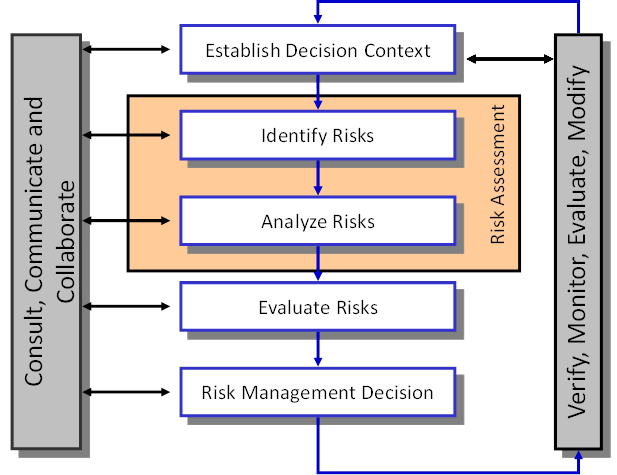The Corps model for managing risk focuses on a multi-part risk assessment process supported through ongoing communication and consultation and regular monitoring and evaluation.
Establish decision context. The goal of establishing decision context is to define the problem; to identify the goals, objectives, strategies and scope of the activity being assessed; and to establish the areas of uncertainty and the criteria for making decisions. This should result in a written:
- Problem statement
- Statement of the activity's objectives
- List of management information questions
- List of the decision criteria
- List of key uncertainties
Identify Risks. Identify the risks relevant to the decision context. This means identifying but not yet quantifying the consequences (positive or negative) and likelihoods and how they will be expressed. This process should result in a narrative description of the risks or significant uncertainties of concern to the risk management activity and a decision on whether or not to pursue a risk assessment.
Analyze Risk. Estimate the consequences and likelihoods of the identified risks. This estimation addresses key uncertainties. The consequence and likelihood for each risk may be combined to produce an estimated level of risk. Alternative mitigation strategies (ways to reduce or limit risk) are analyzed at this point. Together, Identifying risks and analyzing risks comprise the risk assessment task when such a task is required. In some decision contexts, a complete risk assessment may not be needed. Analyzing risk should result in written answers to relevant uncertainties, formulated alternative risk mitigation strategies, characterization of each significant risk with a focus on relevant uncertainties, and a formal risk assessment if required.

Evaluate Risks. Alternatives to reduce or limit risk are evaluated and compared in order to identify the best solution. The evaluation of risks should lead to an effective summary of the most relevant uncertainties and the varying contributions of risk management options to the risk management objective and other social values considered in the decision process.
Risk Management Decision. Develop a risk management strategy, including desired and measurable outcomes. To the extent there is significant analytical uncertainty, the risk management strategy will include an adaptive management plan to reduce such uncertainties. The process of developing the risk management strategy should lead to a determination of a tolerable level of risk, the best risk management option, measurable desired outcomes to monitor the option's success, and an implementation plan.
Communicate & Consult. Throughout the risk management process it is critical to actively communicate and consult with internal and external stakeholders. Review the risk communication page for more information on this part of the process. It also is important to monitor and evaluate results and to modify approaches in response to what is learned.
Monitor, Evaluate, Modify. Post implementation monitoring:
- measures progress toward achieving the desired outcomes of the risk mitigation strategy
- reduces analytical uncertainties identified in the initial planning process as part of an adaptive management plan
- scans the overall setting of the activity to identify hazards or changes in socioeconomic preference or conditions maybe not recognized during the initial risk analysis process, or that may have changed in their significance
In all cases the risk mitigation strategy may be modified in accordance with what is learned.